
Edward Henry O'Hare was born on 13 March 1914 in St. Louis, Missouri. Appointed to the Naval Academy from that state, he was commissioned an Ensign upon graduation in June 1937. For his first duty, he served in the battleship New Mexico. Designated a Naval Aviator in May 1940, after flight training at Naval Air Station, Pensacola, Florida, he was ordered to Fighter Squadron Three (VF-3) on board USS Saratoga. In June, O'Hare was promoted to Lieutenant Junior Grade. In early 1941, while Saratoga underwent maintenance, the squadron temporarily transferred to USS Enterprise. In September, VF-3 departed for duty with Saratoga in the Pacific. In January 1942, after that carrier was struck by a Japanese torpedo off Hawaii, the squadron relocated to USS Lexington. During this time, O'Hare was temporarily promoted to Lieutenant.
On 20 February 1942, while defending Lexington in a F4F "Wildcat" fighter, O'Hare encountered an advancing formation of nine Japanese bombers east of the enemy base at Rabaul, New Britain. Alone and unaided, he repeatedly attacked the enemy aircraft and was credited with shooting down five of them, and damaging a sixth, before they reached their intended target. For his "conspicuous gallantry and intrepidity" on this occasion, O'Hare was meritoriously promoted to Lieutenant Commander in April 1942 and was awarded the Medal of Honor. Returning to the U.S., he embarked on several war bond tours throughout the country. In June, he assumed command of Fighting Squadron Three (VF-3) and served at Maui, Hawaii, instructing pilots in combat tactics.
In mid-1943, O'Hare commanded Fighting Squadron Six (VF-6), flying F6F "Hellcat" fighters from the aircraft carrier Independence during raids against Japanese bases in the central Pacific. In November, as Air Group Six commander on USS Enterprise, O'Hare participated in the Gilbert Islands invasion. On 26 November 1943, O'Hare volunteered to lead a night interception mission against enemy aircraft attacking his task group. His plane was apparently shot down in the ensuing aerial battle, and Lieutenant Commander O'Hare was lost. In memory of the fallen aviator, Chicago's Orchard Depot Airport was renamed O'Hare International Airport in September 1949. Edward H. O'Hare is listed on the "Wall of the Missing" at the National Memorial Cemetery of the Pacific at Honolulu, Hawaii.
USS O'Hare (DD/DDR-889), 1945-1973, was named in honor of Lieutenant Commander Edward H. O'Hare.
This page features the only images we have concerning Edward H. ("Butch") O'Hare.
| If you want higher resolution reproductions than the "Online Library's" digital images, see: "How to Obtain Photographic Reproductions." |
Click on the small photograph to prompt a larger view of the same image.
|
Photo #: 80-G-10562 Lieutenant Edward H. "Butch" O'Hare, USN View taken on 10 April 1942 at Naval Air Station, Maui, Hawaii in the cockpit of his Grumman F4F-3 Wildcat Fighter. He was awarded the Medal of Honor for shooting down five Japanese planes on 20 February 1942, while he was defending USS Lexington during an attempted a raid on the enemy base Rabaul. Official U.S. Navy Photograph, now in the collections of the National Archives. Online Image: 49KB; 595 x 765 pixels Reproductions of this image may also be available through the National Archives photographic reproduction system. |
 |
|
Photo #: NH 106417 Lieutenant Edward H. "Butch" O'Hare, USN Halftone reproduction of a photograph, copied from the official publication "Medal of Honor, 1861-1949, The Navy", page 232. Edward H. O'Hare was awarded the Medal of Honor for "conspicuous gallantry and intrepidity in aerial combat" while serving as Section Leader and Pilot of Fighting Squadron Three (VF-3) in action against the Japanese off Bougainville, 20 February 1942. U.S. Naval History and Heritage Command Photograph. Online Image: 62KB; 580 x 765 pixels |
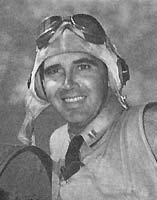 |
|
Photo #: 208-PU-14842 Lieutenant Edward Henry ("Butch") O'Hare, USN Seated in the cockpit of his Grumman F4F "Wildcat" fighter, circa spring 1942. The plane is marked with five Japanese flags, representing the five enemy bombers he was credited with shooting down as they attempted to attack USS Lexington (CV-2) northeast of the Solomon Islands on 20 February 1942. The censor has blanked out the Fighting Squadron Three "Felix the Cat" insignia below the windshield. Photograph from the Office of War Information collection in the U.S. National Archives. Online Image: 117KB; 740 x 610 pixels Reproductions of this image may also be available through the National Archives photographic reproduction system. |
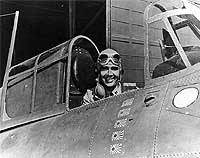 |
|
Photo #: 80-G-K-892-A (Color) Lieutenant Edward H. "Butch" O'Hare, USN Stands by the tail of an F4F "Wildcat" fighter, circa April-May 1942. Note his parachute pack. Online Image: 55KB; 580 x 765 pixels Official U.S. Navy Photograph, now in the collections of the National Archives. Reproductions of this image may also be available through the National Archives photographic reproduction system. |
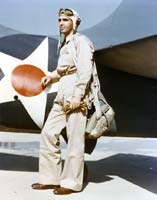 |
|
Photo #: 80-G-K-892-B (Color) Lieutenant Edward H. "Butch" O'Hare, USN Stands beside an F4F "Wildcat", circa April-May 1942. Official U.S. Navy Photograph, now in the collections of the National Archives. Online Image: 60KB; 495 x 765 pixels Reproductions of this image may also be available through the National Archives photographic reproduction system. |
 |
|
Photo #: 80-G-K-13830 (Color) Lieutenant Edward H. "Butch" O'Hare, USN Beside an F4F "Wildcat" fighter, probably circa April-May 1942. USS O'Hare (DD-889) was named in his honor. Official U.S. Navy Photograph, now in the collections of the National Archives. Online Image: 72KB; 575 x 765 pixels Reproductions of this image may also be available through the National Archives photographic reproduction system. |
 |
|
Photo #: 80-G-457493 Lieutenant Edward H. ("Butch") O'Hare, USN, (left) and Lieutenant Commander John S. Thach, USN Shaking hands in front of a Grumman F4F "Wildcat" fighter plane at an Oahu air base, circa April-May 1942. Both men were assigned to Fighting Squadron Three (VF-3), of which Thach was Commanding Officer. Official U.S. Navy Photograph, now in the collections of the U.S. National Archives. Online Image: 109KB; 585 x 675 pixels Reproductions of this image may also be available through the National Archives photographic reproduction system. |
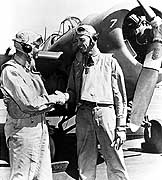 |
|
Photo #: 80-G-10613 Grumman F4F-3 "Wildcat" fighters, of Fighting Squadron Three (VF-3) In flight near Naval Air Station, Kaneohe, Oahu, Hawaii, 10 April 1942. The planes are Bureau # 3976 (marked "F-1), flown by VF-3 Commanding Officer Lieutenant Commander John S. Thach, and Bureau # 3986, flown by Lieutenant Edward H. O'Hare. Both of these aircraft were lost while assigned to Fighting Squadron Two (VF-2) with USS Lexington (CV-2), during the Battle of Coral Sea in May 1942. Photographed by Photographer Second Class H.S. Fawcett. Official U.S. Navy Photograph, now in the collections of the National Archives. Online Image: 111KB; 740 x 620 pixels Reproductions of this image may also be available through the National Archives photographic reproduction system. |
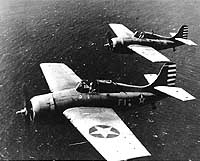 |
|
Medal of Honor citation of Lieutenant Edward H. O'Hare, USN (as printed in the official publication "Medal of Honor, 1861-1949, The Navy", page 232): |
NOTES:
| If you want higher resolution reproductions than the "Online Library's" digital images, see: "How to Obtain Photographic Reproductions." |
Page made 14 January 2009
Edited and reposted 28 September 2009